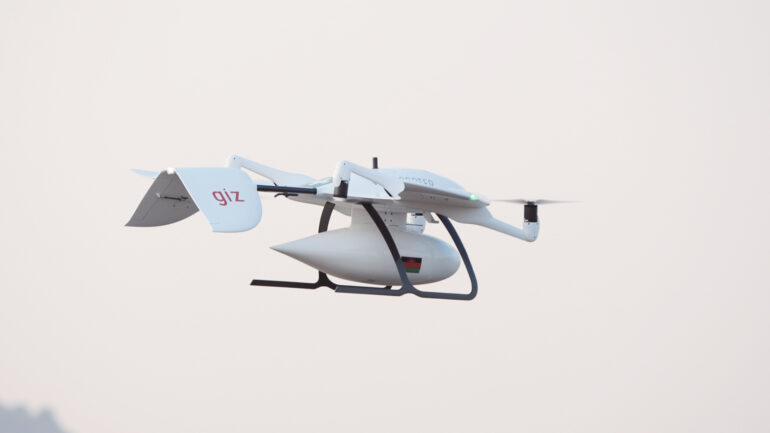Drones are operating increasingly in areas out of sight of the person controlling them. However, conventional remote controls have a limited range, which makes them unsuitable for these flights. On the other hand, simple mobile network-based systems have so far been unable to guarantee a reliable connection when mobile network loads are high or where there is a lack of network coverage. Researchers at the Fraunhofer Institute for Telecommunications, Heinrich-Hertz-Institut, HHI have joined forces with partners in the SUCOM project to develop a new mobile network system that can be used to control drones even over long distances and over difficult terrain.
Autonomous drones that communicate via mobile networks often do not have a stable connection. A lack of network coverage is one explanation for outages. Experts also suspect that drones operating in high altitudes can access too many cell towers at the same time and keep switching between network cells, which can lead to disconnection. Researchers at Fraunhofer HHI, on the other hand, found that the communication protocols that drones use and that regulate the flow of data between the drone and the controller pose problems. If they are not robust enough for fluctuating data rates, some data packets arrive more slowly, and some are lost altogether.
Fraunhofer HHI researchers therefore joined forces with Wingcopter, the Hessian drone manufacturer, Emqopter GmbH and CiS GmbH to develop new communication protocols that are insensitive to jerky data streams. The drone stays connected, even if the data rate fluctuates. Safety-critical information required for the creation of aerial photographs, such as position, altitude, flight direction, speed and other data, can be transmitted without interruption—a key prerequisite for the high safety requirements in aviation.
Highest level of reliability
“For comparison, we equipped a drone with a commercially available LTE system and with our SUCOM mobile network module, which has the new communication protocols,” says Tom Piechotta, a scientist at Fraunhofer HHI. “While the connection that used the conventional module kept dropping out, the SUCOM module provided a stable connection. Thanks to our new protocols, the connection is so stable that there are no interruptions.” For the researcher, this is a clear indication that disruptions in drones are not solely caused by a lack of network coverage.
The SUCOM mobile network module can also be installed in drones that are already in use: In Malawi, for example, drones equipped with the new module deliver medicines, blood supplies and other vital materials to the population during the rainy season, covering distances of up to 40 kilometers. They take off from four airfields, each of which has a “remote pilot” who enters the current route into the system and defines the waypoints that will guide the drone. One click is all it takes to send the flight plan to the drone.
The data needed to make this happen is sent to a server in Cape Town, from where it is transmitted to the SUCOM module and then on to the flight controller on the drone. While in transit, the drone is monitored continuously by the remote pilot in real time. The drone is also equipped with satellite technology, which can be used if the DSL connection fails. The drones can also be operated via a smartphone and VPN connection, if needed.
From Malawi to Berlin in 170 milliseconds
To ensure the rapid transfer of data between the drone and the server in Cape Town, customizations were made to the server hardware and software. The connection is now so fast that the drones in Malawi are able to communicate with Fraunhofer HHI back in Germany in real time. It only takes 170 milliseconds for a data packet to make its way from the drone to Berlin via the server in Cape Town over a mobile communication network.
The SUCOM system could also provide better coverage for remote locations in Germany. To demonstrate this, the project team flew over a large forest area in northern Brandenburg, one of the largest network dead spots in Germany with a diameter of 14 kilometers. The flight was a success. Thanks to the SUCOM module, the drones did not lose connection at any point during the flight.
Provided by
Fraunhofer-Gesellschaft
Citation:
Piloting drones reliably with mobile communication technology (2023, February 3)
